
Combtooth blennies are blenniiformids; percomorph marine fish of the family Blenniidae, part of the order Blenniiformes. They are the largest family of blennies with around 401 known species in 58 genera. Combtooth blennies are found in tropical and subtropical waters in the Atlantic, Pacific and Indian Oceans; some species are also found in brackish and even freshwater environments.

The coastal trevally, also known as the onion trevally, Japanese trevally or bluefin kingfish, is a species of inshore marine fish in the jack family Carangidae. The species is distributed throughout the tropical and subtropical waters of the Indian and west Pacific Oceans, from South Africa in the west to Japan and New Caledonia in the east, reaching as far south as Australia. The species is found on deep coastal reefs, both in schools and as solitary individuals, where they prey on small midwater organisms including crustaceans, small fish and cephalopods. The species is taken as bycatch in a number of fisheries throughout its range by a number of fishing methods and is of little commercial value, but is considered to be a good table fish. A mistype in the original volume in which Eduard Rüppell named the species led to the combination Carangoides caeruleopinnatus, which has incorrectly spread through the literature.
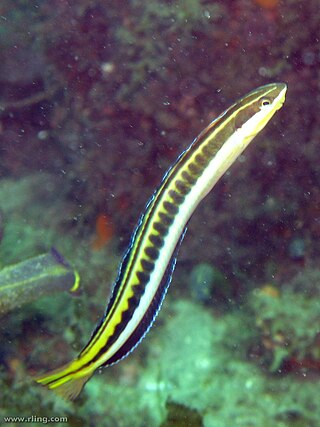
Plagiotremus is a genus of combtooth blennies found throughout the Pacific and Indian oceans.

Hypleurochilus geminatus, the crested blenny, is a species of combtooth blenny found in the western Atlantic ocean. This species grows to a length of 10 centimetres (3.9 in) TL.

Meiacanthus is a genus of combtooth blennies found in the western Pacific and Indian oceans. Many species in this genus make their way into the aquarium trade and several are venomous. The genus name Meiacanthus is derived from the Greek meion meaning "less" and akantha meaning "thorn" and refers to most species having relatively few dorsal fin spines.
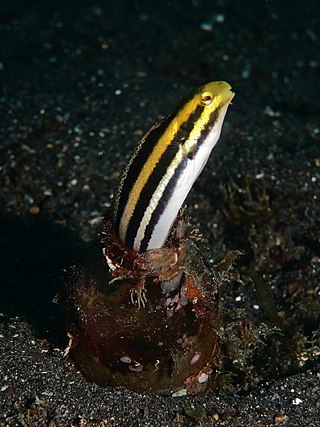
Petroscirtes breviceps, the striped poison-fang blenny mimic, striped fangblenny mimic, short-head sabretooth blenny, short-headed blenny, sabretooth blenny, or the black-banded blenny, is a species of combtooth blenny found in coral reefs in the western Pacific and Indian ocean. This species reaches a length of 11 centimetres (4.3 in) SL.

Petroscirtes fallax, the deceiver fangbelly or yellow saberetooth blenny, is a species of combtooth blenny found in coral reefs in the western Pacific ocean. This species reaches a length of 9.5 centimetres (3.7 in) TL. This is a small species of blenny with a body which is yellow to whitish in colour and is marked with three longitudinal black stripes. The more ventral stripe extending onto the base of the pectoral fin although not to the base of the anal fin. This species is thought to be a possible Batesian mimic of the Lined Fangblenny, Meiacanthus lineatus, which has a pair of venomous canine-like teeth in its lower jaw.

Petroscirtes lupus, the wolf fangbelly, is a species of combtooth blenny found in coral reefs in the western Pacific ocean. This species reaches a length of 13 centimetres (5.1 in) TL. A variably greyish, brown or greenish blenny with six large dark blotches, white dots and dashes on upper sides, and dark dots below. It has two large canines in the lower jaw which are used for defence, although this species is not venomous, and they have been known to bite if handled. They live among sea grass beds, seaweed or the empty shells of molluscs. The female lays her eggs on the interior of a mollusc shell and the male guards them.
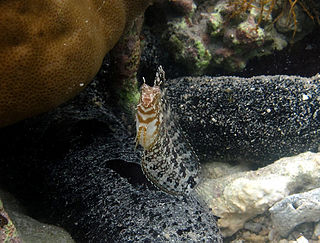
Petroscirtes mitratus, the floral blenny, floral fangblenny, helmeted blenny, or the crested sabretooth blenny, is a species of combtooth blenny found in coral reefs in the Pacific and Indian ocean. This species reaches a length of 8.5 centimetres (3.3 in) TL. It is the type species of the genus Petroscirtes.
Petroscirtes pylei, the twilight fangblenny, is a species of combtooth blenny found in the western central Pacific ocean, around Fiji. This species reaches a length of 4.1 centimetres (1.6 in) SL. The specific name honours the American ichthyologist Richard L. Pyle of the Bishop Museum in Honolulu.
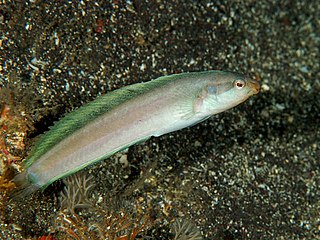
Petroscirtes springeri is a species of combtooth blenny found in coral reefs in the northwest Pacific ocean. This species reaches a length of 7.7 centimetres (3.0 in) SL. The specific name honours the American ichthyologist Victor G. Springer of the United States National Museum, it was Springer who first introduced the author to the blenniids and who suggested the study in which Smith-Vaniz described this species.
Petroscirtes thepassii, the Thepas' sabretooth blenny or the Thepas' fangblenny, is a species of combtooth blenny found in the western central Pacific ocean. This species reaches a length of 5.9 centimetres (2.3 in) SL. The specific name of this blenny honours the collector of the type, the military surgeon A.H. Thepass.
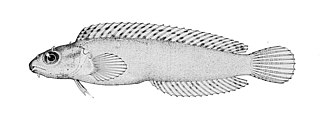
Petroscirtes variabilis, the variable sabretooth blenny, variable fangblenny, or the variable blenny, is a species of combtooth blenny found in the western Pacific and Indian ocean. This species reaches a length of 15 centimetres (5.9 in) TL.
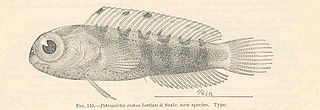
Petroscirtes xestus, the xestus sabretooth blenny, xestus fangblenny, or the bearded sabretooth blenny, is a species of combtooth blenny found in coral reefs in the Pacific and Indian Ocean. This species reaches a length of 7 centimetres (2.8 in) TL.

Plagiotremus phenax, the Imposter fangblenny, is a species of combtooth blenny found in coral reefs in the Indian ocean. This species reaches a length of 8 centimetres (3.1 in) TL. This blenny uses bio mimicry to avoid predation, as it has a strong resemblance to the disco blenny.

Plagiotremus rhinorhynchos, commonly called the bluestriped fangblenny, is a species of combtooth blenny found in coral reefs in the Pacific and Indian ocean. This species reaches a length of 12 centimetres (4.7 in) SL. It is also known as the bluestriped blenny, bluestriped sabretooth blenny, blunt-nose blenny, cleaner mimic, tube-worm blenny or the two-stripe blenny. They hide in deserted worm tubes or other small holes.
Plagiotremus townsendi, Townsend's fangblenny, is a species of combtooth blenny found in coral reefs in the western Indian ocean. This species reaches a length of 6 centimetres (2.4 in) TL.
Adelotremus is a small genus of combtooth blennies which are found in the Indo-Pacific region. The name of the genus is a compound of the Greek Adelos meaning "concealed" and trema meaning "hole", this was coined to reflect that the type of Adelotremus leptus was discovered hiding in a tube made by a polychaete.

Blenniinae is one of two subfamilies in the combtooth blenny family Blenniidae, it is the smallest of the two subfamilies in the Blennidae with 16 genera and 95 species.
Adelotremus deloachi, the spotfin fangblenny, is a species of combtooth blenny from the western Pacific Ocean in Indonesia. The type and paratypes were collected from Bali and the Lembeh Strait. The specimens were collected from depths of 10–17 metres (33–56 ft) from sandy slopes. The specific name honours Ned Deloach, an author and photographer who has written about reef fishes and raised awareness of their conservation.















